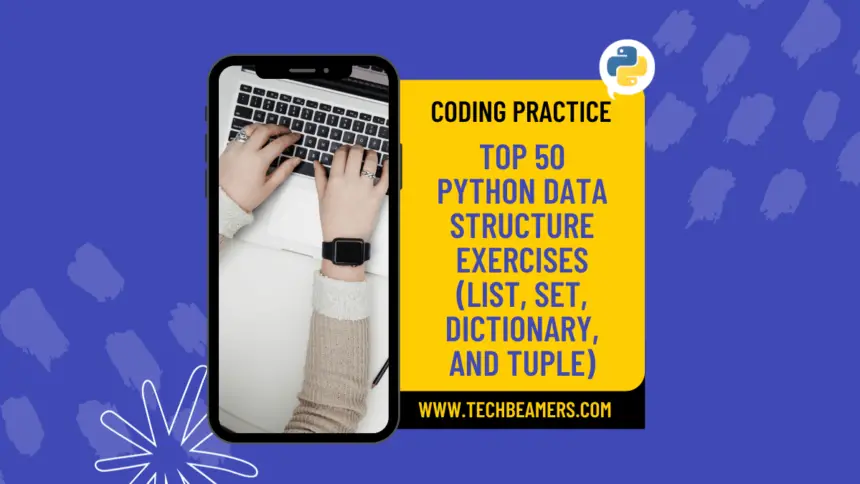Here are 50 Python Data Structure exercises covering List, Set, Dictionary, and Tuple operations. These are excellent exercises for any beginner learning Python.
In the following exercises, you’ll engage in a series of hands-on challenges that traverse the landscape of Lists, Sets, Dictionaries, and Tuples, as well as more advanced concepts like list comprehension. Each exercise is designed not just to impart technical knowledge but to spark your creativity, encouraging you to think critically and express solutions with the eloquence Python provides.
Must Check: 40 Python Exercises for Beginners
Python Data Structure Exercises (List, Set, Dictionary, and Tuple)
As you delve into these Python data structure exercises, consider the context behind each problem. Embrace the beauty of Pythonic syntax, the simplicity that conceals powerful operations, and the joy of creating expressive code. With each exercise, you’re not just solving a problem; you’re composing a piece of code that tells a story.
List Operations:
The one Python data structure that you’ll use the most in your code is the Python list. So, it is essential to practice problems that require using it.
Exercise #1
Problem: Create a list of numbers and find the sum of all elements.
Context: This exercise helps you practice basic list creation and element-wise addition.
Solution:
numbers = [1, 2, 3, 4, 5]
sum_of_elements = sum(numbers)
print(sum_of_elements)Exercise #2
Problem: Remove duplicates from a list and make a unique Python list.
Context: This exercise focuses on utilizing sets to eliminate duplicate elements.
Solution:
original_list = [1, 2, 2, 3, 4, 4, 5]
unique_list = list(set(original_list))
print(unique_list)Exercise #3
Problem: Check if a list is empty.
Context: Understanding how to verify if a list has no elements.
Solution:
my_list = []
is_empty = not bool(my_list)
print(is_empty)Exercise #4
Problem: Reverse a list.
Context: Practice reversing the order of elements in a list.
Solution:
my_list = [1, 2, 3, 4, 5]
reversed_list = my_list[::-1]
print(reversed_list)Exercise #5
Problem: Find the index of a specific element in a list.
Context: Learn how to locate the position of an element in a list.
Solution:
my_list = [10, 20, 30, 40, 50]
element_to_find = 30
index = my_list.index(element_to_find)
print(index)Set Operations:
It is a data structure that has its concept borrowed from the mathematical term called the set. Python set has similar properties as they are in Maths. So, we can confidently say this about the sets in Python:
Sets in mathematics are collections of distinct elements without any specific order. Similarly, in Python, a set is an unordered collection of unique elements.
The Coding Mind
Exercise #6
Problem: Perform union and intersection of two sets.
Context: Understand the concepts of union and intersection in sets.
Solution:
set1 = {1, 2, 3, 4, 5}
set2 = {3, 4, 5, 6, 7}
union_set = set1.union(set2)
intersection_set = set1.intersection(set2)
print(union_set, intersection_set)Exercise #7
Problem: Check if a set is a subset of another set.
Context: Practice checking whether one set is contained within another.
Solution:
set1 = {1, 2, 3}
set2 = {1, 2, 3, 4, 5}
is_subset = set1.issubset(set2)
print(is_subset)Exercise #8
Problem: Remove an element from a set.
Context: Learn how to eliminate a specific element from a set.
Solution:
my_set = {1, 2, 3, 4, 5}
element_to_remove = 3
my_set.remove(element_to_remove)
print(my_set)Exercise #9
Problem: Find the difference between two sets.
Context: Understand how to find elements that exist in one set but not in another.
Solution:
set1 = {1, 2, 3, 4, 5}
set2 = {3, 4, 5, 6, 7}
difference_set = set1.difference(set2)
print(difference_set)Exercise #10
Problem: Check if the two sets have any elements in common.
Context: Determine if there is an intersection between two sets.
Solution:
set1 = {1, 2, 3}
set2 = {3, 4, 5}
have_common_elements = bool(set1.intersection(set2))
print(have_common_elements)Dictionary Operations:
Learning dictionaries in Python is crucial because they help you quickly find information using keys, handle different types of data, and mimic real-life connections. Dictionaries are widely used in Python, making them an essential tool for problem-solving in various applications.
Dictionaries in Python act like real-world dictionaries. They store information as key-value pairs, allowing quick and efficient access to data. Think of a dictionary as a dynamic tool for organizing and managing information in Python. It’s a versatile and essential feature, making tasks like retrieval, insertion, and deletion of data a breeze.
Exercise #11
Problem: Create a dictionary and access its values using keys.
Context: Practice dictionary creation and key-based value retrieval.
Solution:
my_dict = {'name': 'John', 'age': 25, 'city': 'New York'}
age = my_dict['age']
print(age)Exercise #12
Problem: Check if a key exists in a dictionary.
Context: Learn how to verify if a specific key is present in a dictionary.
Solution:
my_dict = {'name': 'John', 'age': 25, 'city': 'New York'}
key_to_check = 'age'
key_exists = key_to_check in my_dict
print(key_exists)Exercise #13
Problem: Merge two dictionaries.
Context: Understand how to combine the contents of two dictionaries.
Solution:
dict1 = {'name': 'John', 'age': 25}
dict2 = {'city': 'New York', 'gender': 'Male'}
merged_dict = {**dict1, **dict2}
print(merged_dict)Exercise #14
Problem: Remove a key-value pair from a dictionary.
Context: Practice deleting a specific entry from a dictionary.
Solution:
my_dict = {'name': 'John', 'age': 25, 'city': 'New York'}
key_to_remove = 'age'
my_dict.pop(key_to_remove, None)
print(my_dict)Exercise #15
Problem: Extract all keys from a dictionary.
Context: Learn how to obtain a list of all keys in a dictionary.
Solution:
my_dict = {'name': 'John', 'age': 25, 'city': 'New York'}
keys_list = list(my_dict.keys())
print(keys_list)Tuple Operations:
Tuples in Python are like unchangeable lists. They allow you to store a collection of items, and once created, their values cannot be modified. Tuples are handy for situations where you want to ensure data integrity or create a set of values that should stay constant throughout your program. They’re lightweight, easy to use, and offer a straightforward way to structure data in Python.
Learning Python tuples is helpful because they keep data safe from accidental changes, can be faster in some cases, and work well with functions that provide multiple results. They’re handy when you want stability in your data or when dealing with functions that use tuples.
Exercise #16
Problem: Create a tuple and perform concatenation.
Context: Practice tuple creation and combining multiple tuples.
Solution:
tuple1 = (1, 2, 3)
tuple2 = (4, 5, 6)
concatenated_tuple = tuple1 + tuple2
print(concatenated_tuple)Exercise #17
Problem: Access elements in a tuple using negative indexing.
Context: Learn how to retrieve elements from a tuple using negative indices.
Solution:
my_tuple = (10, 20, 30, 40, 50)
last_element = my_tuple[-1]
print(last_element)Exercise #18
Problem: Find the length of a tuple.
Context: Practice obtaining the number of elements in a tuple.
Solution:
my_tuple = (10, 20, 30, 40, 50)
length_of_tuple = len(my_tuple)
print(length_of_tuple)Exercise #19
Problem: Check if an element exists in a tuple.
Context: Determine if a specific element is present in a tuple.
Solution:
my_tuple = (10, 20, 30, 40, 50)
element_to_check = 30
element_exists = element_to_check in my_tuple
print(element_exists)Exercise #20
Problem: Convert a tuple to a list.
Context: Understand the process of converting a tuple to
a list.
Solution:
my_tuple = (1, 2, 3, 4, 5)
my_list = list(my_tuple)
print(my_list)These exercises cover a range of operations on Python data structures, providing a solid foundation for working with lists, sets, dictionaries, and tuples. Feel free to explore and modify them to deepen your understanding of Python’s data manipulation capabilities.
Here is the next set of exercises continuing from Exercise #21 to Exercise #50:
Tuple Operations (Continued):
Exercise #21
Problem: Count the occurrences of an element in a tuple.
Context: Learn how to count the number of times a specific element appears in a tuple.
Solution:
my_tuple = (1, 2, 2, 3, 2, 4, 5)
element_to_count = 2
count_occurrences = my_tuple.count(element_to_count)
print(count_occurrences)Exercise #22
Problem: Create a tuple and find the minimum and maximum values.
Context: Practice finding the smallest and largest values in a tuple.
Solution:
my_tuple = (10, 5, 20, 8, 15)
min_value = min(my_tuple)
max_value = max(my_tuple)
print(min_value, max_value)Exercise #23
Problem: Check if all elements in a tuple are the same.
Context: Determine whether all elements in a tuple are equal.
Solution:
my_tuple = (3, 3, 3, 3, 3)
are_all_same = all(x == my_tuple[0] for x in my_tuple)
print(are_all_same)Exercise #24
Problem: Multiply all elements in a tuple.
Context: Practice performing a multiplication operation on all elements of a tuple.
Solution:
my_tuple = (2, 3, 4, 5)
product_of_elements = 1
for element in my_tuple:
product_of_elements *= element
print(product_of_elements)Exercise #25
Problem: Create a tuple of strings and concatenate them.
Context: Explore the concatenation of string elements in a tuple.
Solution:
string_tuple = ('Hello', ' ', 'World', '!')
concatenated_string = ''.join(string_tuple)
print(concatenated_string)List Comprehension:
Sure, here’s a simple description of list comprehension in Python:
List comprehension in Python is a concise and expressive way to create lists. It allows you to generate a new list by applying an expression to each item in an existing iterable (like a list or range). This powerful feature enhances code readability and simplifies the process of creating lists, making it a valuable skill for efficient and clean Python programming.
Learning list comprehension in Python is important because it helps you write shorter, clearer, and more efficient code for creating and modifying lists. It’s like a shortcut that makes your Python programs neater and easier to understand.
Exercise #26
Problem: Generate a list of squares for numbers 1 to 10 using list comprehension.
Context: Practice using list comprehension to generate a new list.
Solution:
squares = [x**2 for x in range(1, 11)]
print(squares)Exercise #27
Problem: Extract odd numbers from a list using list comprehension.
Context: Learn how to filter elements using list comprehension.
Solution:
numbers = [1, 2, 3, 4, 5, 6, 7, 8, 9, 10]
odd_numbers = [x for x in numbers if x % 2 != 0]
print(odd_numbers)Exercise #28
Problem: Create a list of tuples with elements and their squares.
Context: Practice creating tuples and combining them in a list using list comprehension.
Solution:
numbers = [1, 2, 3, 4, 5]
squares_tuples = [(x, x**2) for x in numbers]
print(squares_tuples)Exercise #29
Problem: Flatten a nested list using list comprehension.
Context: Understand how to flatten a list containing nested lists.
Solution:
nested_list = [[1, 2, 3], [4, 5, 6], [7, 8, 9]]
flat_list = [element for sublist in nested_list for element in sublist]
print(flat_list)Exercise #30
Problem: Create a list excluding even numbers using list comprehension.
Context: Practice list comprehension with a condition to exclude certain elements.
Solution:
numbers = [1, 2, 3, 4, 5, 6, 7, 8, 9, 10]
odd_numbers = [x for x in numbers if x % 2 != 0]
print(odd_numbers)Dictionary Comprehension:
Dictionary comprehension in Python is a quick and neat way to create dictionaries. It lets you build a new dictionary by specifying key-value pairs using a simple expression applied to each item in an existing collection. It’s like a shortcut to make your Python code for creating dictionaries shorter and easier to understand.
Learning dictionary comprehension in Python is important because it also helps you write shorter and clearer code for creating dictionaries. It makes your Python programs more efficient and follows the way Python likes things to be done. It’s like a handy tool to make your code neater and smarter.
Exercise #31
Problem: Create a dictionary with keys as numbers and values as their squares using dictionary comprehension.
Context: Practice creating dictionaries using dictionary comprehension.
Solution:
numbers = [1, 2, 3, 4, 5]
squares_dict = {x: x**2 for x in numbers}
print(squares_dict)Exercise #32
Problem: Filter a dictionary to exclude keys divisible by 3 using dictionary comprehension.
Context: Understand how to filter keys in a dictionary using comprehension.
Solution:
original_dict = {1: 'one', 2: 'two', 3: 'three', 4: 'four', 5: 'five'}
filtered_dict = {key: value for key, value in original_dict.items() if key % 3 != 0}
print(filtered_dict)Exercise #33
Problem: Swap keys and values in a dictionary using dictionary comprehension.
Context: Learn how to exchange keys and values in a dictionary.
Solution:
original_dict = {'a': 1, 'b': 2, 'c': 3}
swapped_dict = {value: key for key, value in original_dict.items()}
print(swapped_dict)Exercise #34
Problem: Merge two dictionaries using dictionary comprehension.
Context: Practice combining the contents of two dictionaries using comprehension.
Solution:
dict1 = {'a': 1, 'b': 2}
dict2 = {'c': 3, 'd': 4}
merged_dict = {key: value for d in [dict1, dict2] for key, value in d.items()}
print(merged_dict)Exercise #35
Problem: Create a dictionary excluding keys with values less than 3 using dictionary comprehension.
Context: Practice filtering dictionaries based on values using comprehension.
Solution:
original_dict = {'a': 2, 'b': 1, 'c': 4, 'd': 3}
filtered_dict = {key: value for key, value in original_dict.items() if value >= 3}
print(filtered_dict)Set Comprehension:
Set comprehension in Python is a quick way to create sets. It lets you make a new set by using a simple expression for each item in an existing collection. It’s like a shortcut to create sets easily and neatly in Python.
Doing exercises on set comprehension in Python is good because it helps you write code that’s short and easy to understand. It’s like a handy tool to create unique sets clearly and practically, making your Python programming experience smoother.
Exercise #36
Problem: Create a set of squares for numbers 1 to 5 using set comprehension.
Context: Practice using set comprehension to generate a new set.
Solution:
squares_set = {x**2 for x in range(1, 6)}
print(squares_set)Exercise #37
Problem: Create a set excluding multiples of 3 using set comprehension.
Context: Understand how to filter elements using set comprehension.
Solution:
numbers = {1, 2, 3, 4, 5, 6, 7, 8, 9, 10}
non_multiples_of_three = {x for x in numbers if x % 3 != 0}
print(non_multiples_of_three)Exercise #38
Problem: Create a set of common elements between two sets using set comprehension.
Context:
Learn how to find the intersection of two sets using set comprehension.
Solution:
set1 = {1, 2, 3, 4, 5}
set2 = {3, 4, 5, 6, 7}
common_elements = {x for x in set1 if x in set2}
print(common_elements)Exercise #39
Problem: Create a set of lengths of words in a list using set comprehension.
Context: Practice extracting lengths of words and creating a set using comprehension.
Solution:
words = ['apple', 'banana', 'orange', 'grape']
word_lengths = {len(word) for word in words}
print(word_lengths)Exercise #40
Problem: Create a set of vowels from a given string using set comprehension.
Context: Understand how to extract specific characters from a string using comprehension.
Solution:
my_string = 'hello world'
vowels = {char for char in my_string if char in 'aeiou'}
print(vowels)Advanced Python Data Structure (List) Exercises:
Doing advanced data structure exercises in Python is great because it helps your coding to get better by solving trickier problems. It’s like adding cool tools to your coding toolbox, making your programming skills stronger and more useful for real-life situations.
Exercise #41
Problem: Implement a matrix transposition using list comprehension.
Context: Practice transposing a matrix using nested list comprehension.
Solution:
matrix = [[1, 2, 3], [4, 5, 6], [7, 8, 9]]
transpose_matrix = [[row[i] for row in matrix] for i in range(len(matrix[0]))]
print(transpose_matrix)Exercise #42
Problem: Implement a zip operation on two lists using list comprehension.
Context: Understand how to pair elements from two lists using zip and list comprehension.
Solution:
list1 = [1, 2, 3]
list2 = ['a', 'b', 'c']
zipped_lists = [(a, b) for a, b in zip(list1, list2)]
print(zipped_lists)Exercise #43
Problem: Implement a running sum for a list using list comprehension.
Context: Practice creating a new list with cumulative sums using list comprehension.
Solution:
original_list = [1, 2, 3, 4, 5]
running_sum = [sum(original_list[:i+1]) for i in range(len(original_list))]
print(running_sum)Exercise #44
Problem: Implement a nested list flattening using list comprehension.
Context: Learn how to flatten a nested list using nested list comprehension.
Solution:
nested_list = [[1, 2, 3], [4, 5, 6], [7, 8, 9]]
flattened_list = [element for sublist in nested_list for element in sublist]
print(flattened_list)Exercise #45
Problem: Implement a filter to exclude negative numbers from a list using list comprehension.
Context: Practice filtering elements based on a condition using list comprehension.
Solution:
numbers = [1, -2, 3, -4, 5, -6]
positive_numbers = [x for x in numbers if x >= 0]
print(positive_numbers)Advanced Python Data Structure (Dictionary) Exercises:
Solving exercises on advanced dictionary operations in Python is useful because it makes your code work better, improves your problem-solving skills, and helps you handle real-world data situations more effectively. It’s like adding powerful tools to your coding skills.
Exercise #46
Problem: Merge two dictionaries and sum values for common keys.
Context: Practice merging dictionaries and performing operations on common keys.
Solution:
dict1 = {'a': 1, 'b': 2, 'c': 3}
dict2 = {'b': 4, 'c': 5, 'd': 6}
merged_dict = {key: dict1.get(key, 0) + dict2.get(key, 0) for key in set(dict1) | set(dict2)}
print(merged_dict)Exercise #47
Problem: Group a list of tuples by the first element using dictionary comprehension.
Context: Understand how to group elements in a list of tuples using dictionary comprehension.
Solution:
pairs = [('a', 1), ('b', 2), ('a', 3), ('b', 4)]
grouped_dict = {key: [value for k, value in pairs if k == key] for key in set(k for k, v in pairs)}
print(grouped_dict)Exercise #48
Problem: Extract unique elements and their counts from a list using dictionary comprehension.
Context: Practice creating a dictionary with unique elements and their counts using comprehension.
Solution:
my_list = [1, 2, 2, 3, 3, 3, 4, 4, 4, 4]
unique_counts = {element: my_list.count(element) for element in set(my_list)}
print(unique_counts)Exercise #49
Problem: Find common keys in two dictionaries using dictionary comprehension.
Context: Learn how to find common keys in two dictionaries using comprehension.
Solution:
dict1 = {'a': 1, 'b': 2, 'c': 3}
dict2 = {'b': 4, 'c': 5, 'd': 6}
common_keys = {key for key in dict1 if key in dict2}
print(common_keys)Exercise #50
Problem: Create a dictionary from two lists using dictionary comprehension.
Context: Practice creating a dictionary from two parallel lists using comprehension.
Solution:
keys = ['a', 'b', 'c']
values = [1, 2, 3]
result_dict = {k: v for k, v in zip(keys, values)}
print(result_dict)These Python data structure exercises cover a wide range of operations, including basic manipulations, comprehensions, and more advanced techniques. Feel free to explore and modify them to enhance your understanding and proficiency in Python programming.









